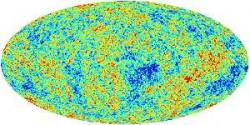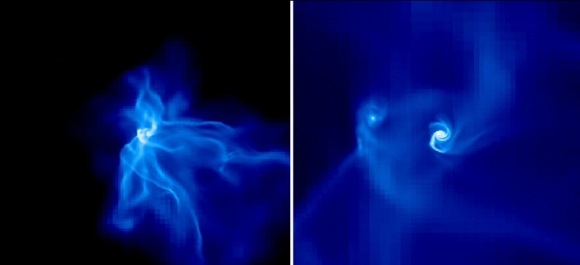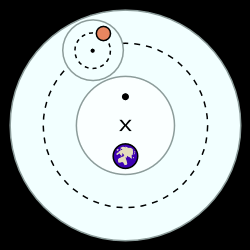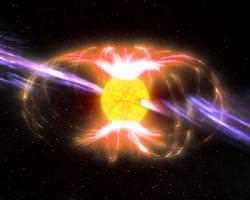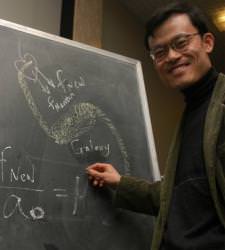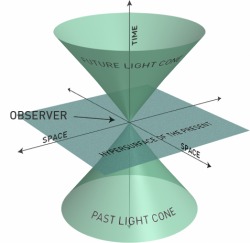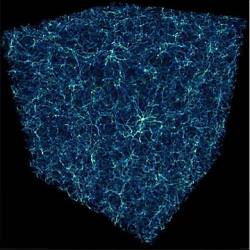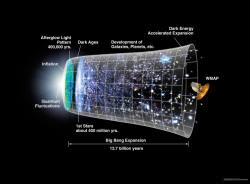What is the universe made of? While general relativity does a good job providing insights into the Big Bang and the evolution of stars, galaxies and black holes, the theory doesn’t help much when it gets down to the small stuff. There are several theories about the basic, fundamental building blocks of all that exists. Some quantum physicists propose string theory as a theory of “everything,” that at the elemental heart of all matter lie tiny one-dimensional filaments called strings. Unfortunately, however, according to the theory, strings should be about a millionth of a billionth of a billionth of a billionth of a centimeter in length. Strings are way too small to see with current particle physics technology, so string theorists will have to come up with more clever methods to test the theory than just looking for the strings.
Well, one cosmologist has an idea. And it’s a really big idea.
Benjamin Wandelt, a professor of physics and astronomy at the University of Illinois says that ancient light from the beginnings of our universe was absorbed by neutral hydrogen atoms. By studying these atoms, certain predictions of string theory could be tested. Making the measurements, however, would require a gigantic array of radio telescopes to be built on Earth, in space or on the moon. And it would be really gigantic: Wandelt proposes an array of radio telescopes with a collective area of more than 1,000 square kilometers. Such an array could be built using current technology, Wandelt said, but would be prohibitively expensive.
So for now, both string theory and this method of testing are purely hypothetical.
According to Wandelt, what this huge array would be looking for are absorption features in the 21-centimeter spectrum of neutral hydrogen atoms.
“High-redshift, 21-centimeter observations provide a rare observational window in which to test string theory, constrain its parameters and show whether or not it makes sense to embed a type of inflation — called brane inflation– into string theory,” said Wandelt. “If we embed brane inflation into string theory, a network of cosmic strings is predicted to form. We can test this prediction by looking for the impact this cosmic string network would have on the density of neutral hydrogen in the universe.”
About 400,000 years after the Big Bang, the universe consisted of a thick shell of neutral hydrogen atoms (each composed of a single proton orbited by a single electron) illuminated by what became known as the cosmic microwave background.
Because neutral hydrogen atoms readily absorb electromagnetic radiation with a wavelength of 21 centimeters, the cosmic microwave background carries a signature of density perturbations in the hydrogen shell, which should be observable today, Wandelt said.
Cosmic strings are filaments of infinite length. Wandelt compared their composition to the boundaries of ice crystals in frozen water.
When water in a bowl begins to freeze, ice crystals will grow at different points in the bowl, with random orientations. When the ice crystals meet, they usually will not be aligned to one another. The boundary between two such misaligned crystals is called a discontinuity or a defect.
Cosmic strings are defects in space. String theory predicts that a network of strings were produced in the early universe, but this has not been detected so far. Cosmic strings produce fluctuations in the gas density through which they move, a signature of which Wandelt says will be imprinted on the 21-centimeter radiation.
Like the cosmic microwave background, the cosmological 21-centimeter radiation has been stretched as the universe has expanded. Today, this relic radiation has a wavelength closer to 21 meters, putting it in the long-wavelength radio portion of the electromagnetic spectrum.
If such an enormous array were eventually constructed, measurements of perturbations in the density of neutral hydrogen atoms could also reveal the value of string tension, a fundamental parameter in string theory, Wandelt said. “And that would tell us about the energy scale at which quantum gravity begins to become important.”
But questions remain about the validity of this experiment. Also, could the array somehow be “shrunk” to search only a small area of the 21-centimeter radiation? Or possibily, could an instrument similar to WMAP (Wilkinson Microwave Anisotropy Probe) be constructed to look at the entire sky for this radiation?
Wandelt and graduate student Rishi Khatri describe their proposed test in a paper accepted for publication in the journal Physical Review Letters, and the paper is not yet available for public review.
Original News Source: University of Illinois Press Release

